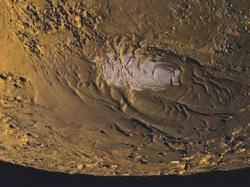I’ll warn you right now, it’s raining Mars news today. Take cover. First up, we’ve got this interesting story. Planetary scientists at MIT have estimated that Mars’ southern pole contains the largest quantity of frozen water in the inner solar system (apart from the Earth, of course). Many people believed that frozen carbon dioxide was the predominant substance in the south pole’s cap, but nope, it’s water.
The research was led by Maria Zuber, MIT professor of geophysics, and the lead investigator for gravity for the Mars Reconnaissance Orbiter. The project is funded by the NASA Mars Program.
Scientists have long suspected that the Martian southern pole was mostly ice and dust, covered by a thin coating of carbon dioxide, but they didn’t have a firm estimate. Zuber and her colleagues used topographical and gravitational data by three Mars spacecraft to find the volume and mass of the ice cap.
Once they had the volume and mass, they were able to calculate the density. The density of water ice is 1,000 kg per cubic metre, while the density of solid carbon dioxide (aka dry ice) is 1,600 kg per cubic metre. Their estimates calculated that the Martian southern pole is about 1,220 kg per cubic metre. That indicates that it’s mostly water, with about 15% silicate dust mixed in.
This makes the southern polar region of Mars the largest body of water in the inner solar system, outside of the Earth. Just in case that’s not clear, we’re talking about Mercury, Venus and Mars.
One thing that’s still puzzling astronomers is the fact that the polar cap doesn’t reflect as much as you would expect from a coating of ice. It’s believed that the silicate dust mixed in dulls down the cap’s reflectivity.
Zuber and her team are planning to estimate the northern polar cap.
Original Source: MIT News Release


WHY IS IT MOSTLY WATER???
ITS NOT ITS ACTUALLY WATER ice
OHHHHH
THNKS
UR WELCOME
MAYBE HE LIKES U
WHAT ???
SRRY I WAS TLKKIN 2 SUMBODY ELSE